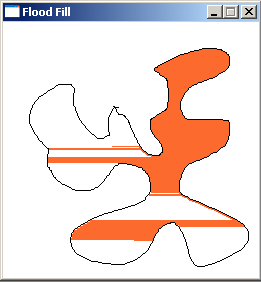
Flood Fill: Flood fill colors. Difference between floodfill and boundary fill algorithm in computer graphics? Update Cancel. Ad by BrainStation. Flood Fill Algorithm. Sometimes we come across an object where we want to fill the area and its boundary with different colors. We can paint such objects with a specified interior color instead of searching for particular boundary color as in boundary filling algorithm. Instead of relying on the boundary of the object, it relies on the fill color. Region Fill Algorithms − Seed Fill Approaches Boundary Fill Flood Fill Work at the pixel level. Suitable for interactive painting applications. Web Xem Phim Tvb Hong Kong more. Jan 12, 2011 The concepts of Boundary Fill Algorithm and. Flood Fill Path Finding Algorithm. Flood Fill algorithm in Computer Graphics.
Filling is the process of “coloring in “a fixed area or region. Epri Orange Book Pdf. Regions may be defined at pixel levels. Filling also means highlighting all the pixels which lie inside the polygon with any color other than the background color. When the regions are defined at pixel level, we are having different algorithms1.Flood Fill Algorithm start from a known interior point and flood the interior until you reach the boundary 2.Scan line Algorithm Determine the overlap intervals of the scan line that cross the (polygon ) area.
Recursive flood fill with 8 directions The flood-fill algorithm takes three parameters: a start node, a target color, and a replacement color. The algorithm looks for all nodes in the array that are connected to the start node by a path of the target color and changes them to the replacement color. There are many ways in which the flood-fill algorithm can be structured, but they all make use of a or data structure, explicitly or implicitly.
Depending on whether we consider nodes touching at the corners connected or not, we have two variations: eight-way and four-way respectively. Stack-based recursive implementation (four-way) [ ] One implicitly stack-based () flood-fill implementation (for a two-dimensional array) goes as follows: Flood-fill (node, target-color, replacement-color): 1. If target-color is equal to replacement-color, return. If the color of node is not equal to target-color, return. Set the color of node to replacement-color. Perform Flood-fill (one step to the south of node, target-color, replacement-color).
Perform Flood-fill (one step to the north of node, target-color, replacement-color). Perform Flood-fill (one step to the west of node, target-color, replacement-color). Perform Flood-fill (one step to the east of node, target-color, replacement-color). Though easy to understand, the implementation of the algorithm used above is impractical in languages and environments where stack space is severely constrained (e.g. Alternative implementations [ ] An explicitly queue-based implementation (sometimes called 'Forest Fire algorithm' ) is shown in pseudo-code below. It is similar to the simple recursive solution, except that instead of making recursive calls, it pushes the nodes onto a for consumption: Flood-fill (node, target-color, replacement-color): 1.
If target-color is equal to replacement-color, return. If color of node is not equal to target-color, return. Set Q to the empty queue. Set the color of node to replacement-color. Add node to the end of Q. While Q is not empty: 7.
Set n equal to the first element of Q. Remove first element from Q. If the color of the node to the west of n is target-color, set the color of that node to replacement-color and add that node to the end of Q.
Facebook Hack V 1.0 - 2013. If the color of the node to the east of n is target-color, set the color of that node to replacement-color and add that node to the end of Q. If the color of the node to the north of n is target-color, set the color of that node to replacement-color and add that node to the end of Q. If the color of the node to the south of n is target-color, set the color of that node to replacement-color and add that node to the end of Q. Continue looping until Q is exhausted.
Most practical implementations use a loop for the west and east directions as an optimization to avoid the overhead of stack or queue management: Flood-fill (node, target-color, replacement-color): 1. If target-color is equal to replacement-color, return. If color of node is not equal to target-color, return. Set Q to the empty queue. Add node to Q. For each element N of Q: 6.
Set w and e equal to N. Move w to the west until the color of the node to the west of w no longer matches target-color.
Move e to the east until the color of the node to the east of e no longer matches target-color. For each node n between w and e: 10. Set the color of n to replacement-color. If the color of the node to the north of n is target-color, add that node to Q.
If the color of the node to the south of n is target-color, add that node to Q. Continue looping until Q is exhausted.
Adapting the algorithm to use an additional array to store the shape of the region allows generalization to cover 'fuzzy' flood filling, where an element can differ by up to a specified threshold from the source symbol. Using this additional array as an allows the edges of the filled region to blend somewhat smoothly with the not-filled region.